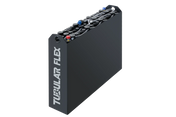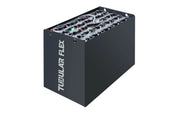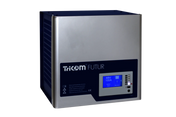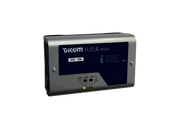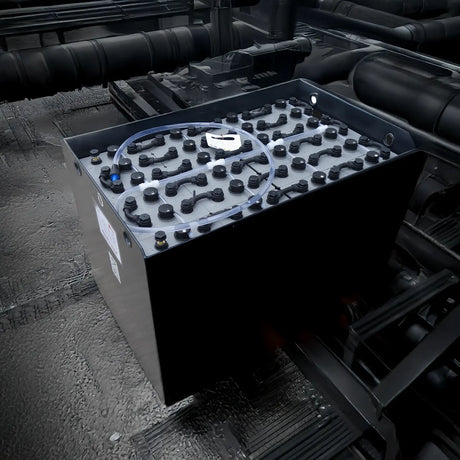Electric forklifts and industrial trucks rely on powerful traction batteries. Differences in design, cell chemistry, and charging behavior directly impact performance, service life , and operating costs .
In this article, you will learn how forklift batteries are constructed, which technologies are relevant in practice, and what you should pay attention to when selecting, operating, and maintaining them.
How is a forklift battery constructed?
A forklift battery consists of several battery cells connected in series or parallel to achieve the desired nominal voltage (e.g., 24 V, 48 V, or 80 V). Each cell contains an anode (negative pole) and cathode (positive pole), separated by a separator and surrounded by an electrolyte . Through electrochemical reactions, chemical energy is converted into electrical energy—and back again during charging.
Essential components of a forklift battery
- Cells: Depending on the type, approx. 2 V (lead) or 3.6 V (lithium-ion) per cell.
- Electrolyte: sulfuric acid (lead), silica gel or glass mat (VRLA), organic solution (Li-Ion).
- Separators: Microporous PE/PP separators for lead-acid batteries; ceramic-coated polyolefin separators (PE/PP) for Li-ion cells for higher temperature stability.
- Housing: Acid-resistant steel trough or plastic with insulation and cell fixation.
What types of batteries are used in forklifts?
In practice , lead-acid batteries (PzS) and their VRLA variants (gel and AGM), as well as modern lithium-ion systems , dominate. Nickel-cadmium hardly plays a role anymore.
Lead-acid and VRLA batteries (PzS / Gel / AGM)
VRLA stands for Valve Regulated Lead Acid . This collective term includes:
- Gel batteries: Electrolyte bound in silica gel – leak-proof and low-maintenance.
- AGM batteries: Electrolyte bound in a glass fiber mat (absorbent glass mat) – high current carrying capacity and vibration-resistant.
Both versions are closed, produce hardly any gas and do not require refilling with water.
Advantages
- Proven and cost-effective technology
- High reliability in daily operation
- VRLA systems: completely maintenance-free
Disadvantages
- PzS batteries: regular inspection and water maintenance required
- Long charging times (6 – 10 hours)
- Weight and sensitivity to deep discharge
Service life & cycle stability
- PzS lead-acid: approx. 1,200 cycles at 80% DOD, up to 1,500 cycles at 50% DOD
- VRLA (AGM/Gel): 1,000 – 1,200 cycles
Lithium-ion batteries
Li-ion batteries are the most modern solution for demanding multi-shift or rapid-charging applications. They use liquid organic electrolytes and polyolefin (PE/PP) separators with a ceramic coating for increased safety. An integrated battery management system (BMS) continuously monitors temperature, voltage and charge level.
Advantages
- Efficiency up to 95%
- Cycle life > 3 000 charging cycles
- Fast charging (1 – 2 h) and maintenance-free
- Active temperature management (20 – 40 °C, shutdown > 55 °C)
Disadvantages
- Higher acquisition costs
- More complex recycling process
How does a forklift battery work?
When charging, electrical energy is stored chemically and released again when discharging . The typical charging process follows the IUoU or IUoI characteristic curve with three phases:
- Bulk phase (I): Constant current charging to approximately 80% capacity. The voltage gradually increases.
- Absorption phase (Uo): constant voltage charging; the current decreases continuously until it reaches about 3% of the bulk current.
- Float charge (U): “Float” or “Trickle” – voltage is reduced to keep the battery fully charged without causing gassing.
Temperature compensation is important for lead-acid batteries : At ambient temperatures above 25°C, the charging voltage should be reduced by -3 mV per °C per cell to prevent gassing and corrosion. Modern chargers adjust these values automatically.
Temperature management and efficiency
High temperatures (> 40 °C)
- Increase reaction rate, but shorten lifespan and promote water loss in lead.
- For Li-Ion, the BMS takes over the active power limitation or shutdown > 55 °C.
Low temperatures (< 10 °C)
- Slow down ion movement and reduce capacity.
- Li-ion retains around 80% power, lead often only 50 – 60%.
- Heating systems or insulated troughs compensate for cold losses.
Separators and materials in detail
The separator is crucial for efficiency and safety. It electrically separates the anode and cathode, but allows ions to pass through – and prevents short circuits.
- Lead batteries: microporous PE/PP separators – acid-resistant, gas-permeable, and long-term stable.
- Lithium-ion: PE/PP polyolefin separators with ceramic coating – improved heat and safety resistance.
Performance data in comparison
| technology | Efficiency | Cycle stability | Loading time | maintenance |
|---|---|---|---|---|
| Lead-acid (PzS) | ≈ 75% | 1,200 – 1,500 cycles | 6 – 10 hours | regularly |
| VRLA (Gel / AGM) | ≈ 80% | 1 000 – 1 200 cycles | 6 – 8 hours | small amount |
| Lithium-ion | ≈ 95% | > 3 000 cycles | 1 – 2 hours | maintenance-free |
Conclusion: Which battery technology is suitable for your application?
Lead-acid batteries (PzS) are robust, inexpensive and easy to recycle – ideal for standard applications with predictable charging times. VRLA systems (Gel / AGM) offer low-maintenance operation and are particularly advantageous in sensitive environments. Lithium-ion batteries deliver maximum efficiency, short charging cycles, and a long service life – ideal for multi-shift operations or automated logistics.
Anyone seeking to combine efficiency, safety, and durability should pay attention not only to the technology but also to the appropriate charging method, temperature management, and accessories. This will ensure that forklift operations remain efficient and economical over the long term.


